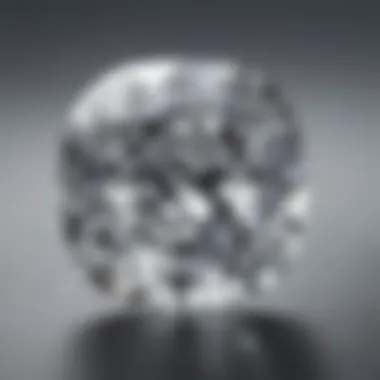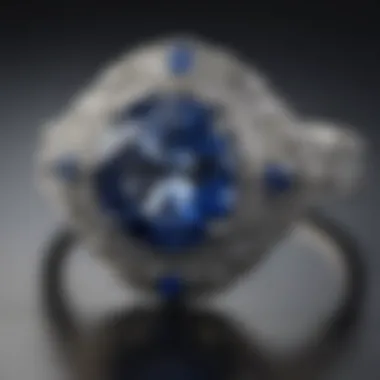The Allure of White Sapphire Set in White Gold


Intro
White sapphire has gained recognition in the realm of fine jewelry, not only for its beauty but also for its striking resemblance to diamond. When paired with white gold, it creates a captivating aesthetic that attracts many gem enthusiasts. This article examines the elegance of white sapphire set in white gold, emphasizing important characteristics, ethical sourcing, and historical significance.
Gemstone Overview
Definition and Characteristics
White sapphire is a corundum variety, specifically devoid of any color impurities that would typically give gem material its vivid hues. This transparency is a defining attribute, allowing light to refract beautifully and exhibit a level of brilliance. White sapphire maintains a hardness of 9 on the Mohs scale, making it quite durable for everyday wear.
Key characteristics of white sapphire include:
- Excellent durability
- Clarity and brilliance similar to diamonds
- Affordability compared to traditional diamonds
- Ethical sourcing potential due to its natural origin
Classification of Gemstones
Gemstones are generally classified based on several criteria: geology, rarity, and origin. In the context of white sapphire:
- Geology: It is categorized as a natural gemstone formed from aluminum oxide crystalline structure.
- Rarity: While sapphires come in many colors, white sapphires are less common, contributing to their unique appeal.
- Origin: Sourcing can occur from various locations such as Sri Lanka, Madagascar, and Australia.
Properties of Gemstones
Physical Properties
The physical properties of white sapphire render it a suitable choice for jewelry. It exhibits a colorless appearance with superior clarity and a high refractive index. The stone is also resistant to scratches and stains, enhancing its longevity.
Main physical properties are:
- Hardness: 9 on the Mohs scale
- Specific Gravity: Approximately 4.0
- Transparency: Colorless to nearly colorless
Chemical Properties
In terms of chemical composition, white sapphire is primarily made up of aluminum oxide (Al2O3). Its chemical stability contributes to the crystal's clarity and brilliance, allowing it to maintain its appeal over time.
"White sapphires are often considered a viable alternative to diamonds, providing beauty without the associated ethical concerns."
Epilogue
The allure of white sapphire set in white gold lies not just in their aesthetic appeal but also in the significant properties and ethical considerations associated with their sourcing. Understanding these aspects allows buyers to make informed choices in the world of fine jewelry.
Prelude to White Sapphire and White Gold
The choice of gemstones and metals in jewelry is often driven by aesthetic appeal and personal significance. White sapphire, known for its brilliance and clarity, presents a compelling alternative to traditional diamonds. When paired with white gold, its beauty is further enhanced, prompting a deeper exploration into the characteristics and values of these materials. Understanding the synergies between white sapphire and white gold is essential for anyone interested in high-quality jewelry.
Definition of White Sapphire
White sapphire is a precious gemstone, composed primarily of aluminum oxide. Unlike its more famous counterpart, diamond, white sapphire is less expensive while still offering substantial sparkle and clarity. This mineral occurs naturally in various regions worldwide, often being cut into multiple shapes to maximize its brilliance.
In terms of appearance, white sapphire can be remarkably similar to diamond, with a colorless quality that allows it to reflect light beautifully. However, it tends to have slight inclusions, which can give it a distinct character.
This gemstone serves not only aesthetic purposes but also symbolizes purity and sincerity, making it a popular choice for engagement rings and other significant pieces of jewelry.
Overview of White Gold
White gold is an alloy that combines yellow gold with other metals, such as palladium or nickel, to achieve a silvery appearance. This alloy mix enhances durability while maintaining a luxurious touch. Its color resonates well with modern and sophisticated designs, appealing to a wide audience.


The production of white gold involves a process where pure gold is alloyed with metals that can influence its hardness and color. Rhodium plating often coats white gold, further increasing its shine and providing protection against scratches.
Beyond its beauty, white gold holds strong sentimental value. Jewelry crafted from this metal is frequently chosen for special occasions. Its subtle elegance offers versatility, complementing various gemstones, including white sapphire.
"White sapphire and white gold form a harmonious partnership, enhancing the inherent beauty of each material."
Through these definitions, it becomes clear that the relationship between white sapphire and white gold is not only aesthetic but also rooted in the qualities that each brings to fine jewelry. This introduction sets the stage for exploring their historical contexts, properties, and practical considerations in greater detail throughout the article.
The Historical Context
Understanding the historical context of white sapphire and white gold enriches our appreciation for these materials in contemporary jewelry design. This background provides insight not just into their aesthetic significance, but also their cultural relevance throughout various periods. The evolution of how different civilizations have utilized these materials reflects broader trends in artistry, trade, and societal values. In examining this history, we can better grasp the modern implications and ethical considerations that accompany these choices in today's marketplace.
Historical Uses of Sapphire
Sapphires have a long history that transcends mere decoration. They were prized in ancient cultures for supposed protective properties, often believed to safeguard wearers from harm and misfortune. The allure of sapphires, particularly blue and white variants, captivated royals and dignitaries, who adorned themselves with these gems in a demonstration of power and status.
- Religious Significance: In many ancient cultures, sapphires were associated with divine qualities. For instance, in Hindusim, blue sapphires are linked to the heavenly bodies, believed to connect humans to divine energies.
- Symbol of Wisdom and Purity: Throughout history, sapphires have been seen as symbols of wisdom and purity. Medieval clergy wore sapphires in rings, believing them to keep their thoughts and intentions true.
- Royal Connections: The connection between sapphires and nobility is notable. The famed engagement ring of Princess Diana, now worn by Kate Middleton, features a large blue sapphire, demonstrating the ongoing prestige linked to the stone.
- Healing Properties: In various traditions, sapphires were thought to encompass healing properties. They were used in amulets, intended to bring balance and tranquility to one’s life.
As time progressed, the white variant of the sapphire began to be appreciated for its clarity and brilliance, often used in fine jewelry pieces that enhance, rather than distract from, the craftsmanship of the setting.
The Evolution of White Gold
White gold, emerging in the 19th century as an appealing counterpart to yellow gold, was initially developed to provide a modern aesthetic without sacrificing durability. Its advantages lie in both its makeup and appearance, influencing its adoption across various contexts.
- Formulation: White gold is an alloy, primarily composed of yellow gold mixed with metals such as palladium or nickel. This alloying was essential for creating a lustrous appearance that mimicked platinum, all while offering better value.
- Popularity in Jewelry: The 20th century saw a surge in the popularity of white gold due to its stylishness and suitability for engagement rings and wedding bands. The clean, crisp finish complements many stones, making it a preferable choice for designers and consumers alike.
- Cultural Shifts: Over the decades, changing fashion trends helped elevate white gold to a staple in both casual and formal jewelry. Its adaptability is appreciated in settings from sleek modern styles to vintage-inspired pieces.
- Challenges in the Market: Despite its popularity, the use of nickel in white gold has raised concerns over allergies, leading some manufacturers to explore alternative alloys. The market has started offering options such as palladium-based white gold, appealing to those seeking hypoallergenic properties.
In summary, white gold has undergone significant changes that not only involve its physical composition but also its cultural perception. The evolution of both sapphire and white gold reveals deep connections between material value, personal significance, and artistic expression in jewelry.
Properties of White Sapphire
Understanding the properties of white sapphire is essential for anyone interested in fine jewelry, especially those who appreciate its unique blend of hardness and clarity. Unlike diamonds, white sapphires have their distinct charm that captivates various audiences, including gemstone enthusiasts and jewelry designers. One important aspect to highlight is that the properties significantly impact the stone's longevity, aesthetic appeal, and overall value.
Chemical Composition
White sapphire is primarily composed of aluminum oxide, known scientifically as corundum. Its chemical formula is Al₂O₃, which is the same as that of colored sapphires but lacks the trace elements that impart color. The absence of these elements gives white sapphire its transparent appearance. This unique composition allows it to reflect light effectively, contributing to its beauty. In addition, the purity of the crystal lattice in white sapphire is crucial; any inclusions or flaws can dramatically reduce its appeal and value. Thus, when choosing white sapphires, understanding their chemical makeup provides insight into their quality and desirability in the market.
Durability and Hardness
One remarkable aspect of white sapphire is its high durability. With a hardness rating of 9 on the Mohs scale, it is second only to diamond. This characteristic makes white sapphire an excellent choice for everyday wear, as it resists scratches and abrasions effectively. For jewelry designers, this durability opens up diverse design options without compromising on longevity. By comparison, softer gemstones may require more protective settings, illustrating the practical benefits of choosing white sapphire. This durability ensures that the stone remains beautiful even when set in active wear pieces such as rings that undergo daily friction.
Optical Characteristics
The optical properties of white sapphire are noteworthy. While it does not exhibit the same brilliance as a diamond, it possesses a unique allure thanks to its clarity and transparency. White sapphire can display a soft luster when cut and polished correctly. Certain cuts, such as oval or cushion shapes, enhance its brilliance and allow light to flow through the gemstone more effectively. Moreover, white sapphires offer excellent colorlessness, which makes them versatile and appealing for various jewelry styles. Collectors and designers alike appreciate these optical characteristics as they play a crucial role in the overall aesthetic of gemstone and metal pairings.
"Understanding the properties of white sapphire enhances appreciation and supports informed purchasing decisions."
In summary, the properties of white sapphire, from its chemical composition to its durability and optical characteristics, significantly influence its market position and desirability. Recognizing these elements is vital for buyers and collectors aiming to make informed choices in their gemstone investments.
Characteristics of White Gold
White gold has gained prominence in the world of fine jewelry, particularly for its compatibility with various gemstones, including white sapphire. It offers a unique balance of aesthetic appeal and practical functionality that sets it apart in the market. The characteristics of white gold influence both the look and the durability of jewelry crafted in this metal. Understanding these attributes is crucial for buyers seeking exquisite pieces that maintain their beauty over time.
Alloys Used in White Gold
White gold does not exist as a pure metal; instead, it is an alloy. Typically, white gold is made by combining pure gold with metals such as palladium or nickel. The percentage of gold in white gold can vary, which is often reflected in the karat designation. Common variations include 14k and 18k white gold.


- Palladium: This is a platinum group metal that contributes to the luxurious feel and enhances the metal's resistance to tarnish.
- Nickel: Known for its strength, nickel is a frequently used metal in white gold. However, it can cause allergic reactions in some individuals.
- Silver: Sometimes included to improve fluidity and workability during the alloying process.
The choice of alloy is significant because it directly affects the color and characteristics of white gold. Palladium-based alloys will typically have a lighter appearance compared to those made with nickel.
Benefits of White Gold Over Yellow Gold
Opting for white gold over traditional yellow gold offers several distinct advantages.
- Color Versatility: White gold complements various gemstones, such as white sapphire, making it a preferred choice for modern jewelry designs.
- Modern Aesthetic: The sleek and understated elegance of white gold appeals to contemporary tastes, adapting well to both formal and everyday settings.
- Durability: White gold typically has a higher hardness due to the inclusion of stronger metals in the alloy, which affords better resistance to scratches and dents compared to yellow gold.
- Rhodium Plating: Many jewelers coat white gold with rhodium for an additional layer of protection and shine. This plating enhances luster, giving the piece a brilliant finish.
"The choice between white gold and other metals often comes down to personal preference but understanding the characteristics can lead to more informed decisions."
Designing with White Sapphire and White Gold
The act of designing with white sapphire set in white gold is both an art and a science. This section delves into the elements and benefits connected with this combination, highlighted by a clear understanding of current trends and setting types.
Jewelry Design Trends
Jewelry design is continuously evolving, and the incorporation of white sapphire and white gold has become significantly prominent. The purity of white sapphire coupled with the sleek elegance of white gold creates a captivating aesthetic that appeals to many. Recent trends reflect a shift towards minimalist designs, where a single white sapphire can become the focal point amidst delicate white gold settings. Such designs appeal to those looking for subtlety without sacrificing elegance.
An emerging trend is the use of geometric shapes and clean lines. This approach allows the gemstone to command attention while the metal enhances its brilliance. Notably, vintage styles are also making a comeback; art deco and retro designs often feature intricate details in white gold, creating an allure that complements the gemstone.
Additionally, there is increased interest in custom pieces, driven by personal expression and individuality. Consumers are seeking bespoke jewelry that tells their stories, and designers are responding by creating unique compositions that blend white sapphires and white gold in innovative ways.
Setting Types for White Sapphire
When it comes to white sapphire, the setting is crucial in highlighting its characteristics. The choice of setting not only affects the aesthetic but also the protection of the gemstone.
1. Prong Setting: This type is the most common for white sapphires. It uses metal prongs to hold the gemstone securely while allowing maximum light to pass through. This approach enhances the stone’s brilliance and sparkle.
2. Bezel Setting: A bezel setting encircles the gemstone completely with metal, providing a modern and sophisticated look. It offers excellent protection to the stone, making it an ideal choice for those with active lifestyles.
3. Pave Setting: Small diamonds or white sapphires are set closely together to create a shimmering effect. This type of setting can amplify the sparkle of larger center stones, enhancing the overall brilliance of the piece.
Important Note: The choice of setting can significantly influence both the appearance and the care required for the piece.
Practical Considerations
When considering white sapphire set in white gold, understanding practical aspects is crucial. This section focuses on care, maintenance, and lifecycle management for both the gemstone and the metal. While the beauty and elegance of white sapphires in white gold are striking, their upkeep is paramount to ensure longevity and sustained visual appeal. For jewelers and collectors alike, practicality offers not just aesthetic benefits but also economic justification.
Care and Maintenance of White Sapphire
White sapphires require regular care to maintain their brilliance. Despite being durable, they can accumulate dirt and oils from daily wear. Here are some key tips for maintaining the condition of white sapphires:
- Gentle Cleaning: Use a soft toothbrush and mild soap mixed with warm water. Scrub the stone gently to remove grime.
- Avoid Harsh Chemicals: Never use bleaches or strong cleaning agents as they may damage the gemstone.
- Store Properly: Keep white sapphire jewelry in a soft pouch or a lined box to avoid scratches from other jewelry pieces.
The overall durability of white sapphires makes them suitable for everyday wear; however, routine checks are wise. Look out for any signs of loose settings, as this could lead to potential loss.
White Gold Care Guidelines
White gold, although alloyed to enhance durability, still requires attention to maintain its luster. The following practices are recommended for proper care of white gold jewelry:
- Regular Polishing: Use a specialized jewelry polishing cloth to keep the surface shiny. This can help remove surface tarnish.
- Avoid Contact with Chemicals: Chlorine and other harsh substances are detrimental to white gold. It's advisable to remove white gold jewelry before swimming or using cleaning products.
- Periodic Professional Cleaning: Consider taking your jewelry to a professional cleaner at least once a year. They can check for wear and provide a deeper clean.
Maintaining white gold not only imparts a long-lasting shine but also assures that the white sapphire remains securely set.


Ethical Sourcing
Ethical sourcing has become a pressing topic in today's jewelry market and for good reason. As consumers become more aware of the implications of their purchases, understanding the origins of gemstones and metals is critical. This section delves into the significance of responsible sourcing practices for white sapphire and white gold, emphasizing their benefits and the considerations involved.
Responsibility in Gemstone Sourcing
Sourcing gemstones ethically ensures that the extraction process does not harm local communities or the environment. White sapphires, while not as commonly associated with geopolitical issues as other gemstones, still benefit from a transparent supply chain. Gemstone sourcing should prioritize the welfare of workers who mine these stones. Emphasizing fair labor practices not only fosters a positive image but also draws conscientious consumers.
When looking for ethically sourced white sapphires, it’s essential to verify the supplier's practices. Questions to ask include:
- How do you source your gemstones?
- What measures are taken to ensure fair labor practices?
- Is there oversight from independent organizations?
By ensuring that white sapphires come from reputable sources, buyers can feel good about their choices, knowing they are supporting ethical practices in the gemstone industry.
Sustainable Practices in Jewelry Manufacturing
Sustainable practices within jewelry manufacturing play a vital role in minimizing environmental impact. For white gold, which is often alloyed with metals like palladium or nickel, the process of sourcing these materials needs to be sustainable as well. Prioritizing recycled metals can significantly reduce the ecological footprint that new mining operations cause.
Some practices to consider include:
- Use of Recycled Materials: Opt for jewelers who utilize recycled gold in their white gold creations. This approach reduces the need for mining new metals, thus preserving ecosystems.
- Waste Management: Responsible manufacturers should implement systems to manage and reduce waste generated during the production process.
- Energy Efficiency: Look for companies that invest in energy-efficient practices, such as using renewable energy sources in their operations.
"Ethical sourcing isn't just a trend; it's a commitment to preserving both humanity and nature while crafting beauty."
Marketplace Insights
The realm of gemstone jewelry, specifically featuring white sapphire set in white gold, requires a calculated approach. Understanding the marketplace is crucial for both buyers and sellers. Market insights enable informed decision-making regarding investments and purchases. It encompasses a variety of factors such as pricing, quality, ethical sourcing, and customer preferences.
By examining the marketplace for white sapphire and white gold, one can identify the nuances that influence perceived value. Consumers are often seeking a perfect blend of beauty and ethical considerations. Therefore, knowledge about these aspects can significantly impact choices and enhance satisfaction with purchases.
Pricing Factors for White Sapphire and White Gold
When evaluating the pricing of white sapphire and white gold, it is essential to consider several key factors:
- Quality of the Stone: The clarity, cut, carat weight, and color can greatly influence the overall price of white sapphires. Higher quality stones with fewer inclusions are naturally more expensive.
- Gold Content: The purity of white gold is measured in karats. For instance, 18K white gold has higher gold content compared to 14K. This affects not only the price but also the durability and hue of the jewelry.
- Market Trends: Changes in supply and demand can fluctuate prices. Seasonal trends and consumer preferences can also affect pricing.
- Certification: Certified gemstones tend to have higher market values. Certificates from recognized institutions add credibility to the purchase.
"Understanding the pricing factors is fundamental in making an informed purchase that aligns with your budget and expectations."
Key Retailers and Arias
Buying white sapphire in white gold can be simplified by knowing where to look. There are several notable retailers that specialize in fine jewelry, particularly those featuring sapphires:
- Tiffany & Co.: Known for their timeless designs and high-quality gemstones, Tiffany often includes white sapphires in their collections.
- Blue Nile: This online retailer offers an extensive selection of white sapphire jewelry in white gold, appealing to a wider audience.
- James Allen: They provide a variety of options with the added benefit of viewing 360-degree images of the gems, ensuring clarity in selection.
- Brian Gavin Diamonds: Renowned for their personalized service, they also offer various options for white sapphire settings.
Each of these retailers has established trust and quality in the marketplace. By selecting a reputable seller, buyers can ensure they acquire authentic gems with favorable characteristics.
End and Future Perspectives
The conclusion encapsulates the key insights discussed in this article. It emphasizes the unique appeal of white sapphire set in white gold, noting how these two elements complement each other both aesthetically and symbolically. White sapphires provide an ethical and cost-effective alternative to traditional diamonds, while white gold enhances their brilliance. This dynamic combination invites a fresh perspective among buyers and collectors, illuminating a path towards more conscientious jewelry choices.
Recap of Key Points
- White Sapphire Characteristics: White sapphire is renowned for its clarity and brilliance, offering an exquisite alternative to diamonds without the hefty price tag.
- White Gold Properties: White gold, consisting of gold mixed with other metals, is valued for its strength and durability while maintaining a luxurious appearance.
- Historical Significance: Throughout history, both white sapphires and white gold have been used in jewelry to signify elegance and purity, reinforcing their status in the fine jewelry market.
- Ethical Considerations: Attention to the sourcing of gemstones has grown, making white sapphires an appealing choice for those concerned with ethical practices.
- Market Trends: There is a notable shift towards the use of sustainable materials in jewelry manufacturing, influencing future designs and offerings.
The Future of White Sapphire in Jewelry
Looking ahead, white sapphires are poised for a significant place within the jewelry market. As consumers become increasingly aware of the environmental and ethical implications of their purchases, the demand for white sapphire is likely to rise. Manufacturers are expected to innovate their practices and designs, ensuring that these gems are not only beautiful but also responsibly sourced. Moreover, designers are incorporating white sapphires into contemporary settings, appealing to a diverse clientele.
"The elegance of white sapphire in white gold is not just a trend; it reflects a deeper commitment to sustainability and ethical avenues in luxury jewelry."
Whether it is through a classic design or bold innovative approaches, the future of white sapphire within the realm of fine jewelry seems promising. The intersection of beauty, ethics, and personal expression will guide its journey forward, indicating a fruitful horizon for gemstone enthusiasts and collectors. The allure of white sapphire will undoubtedly continue to captivate, ensuring its place as a staple in the jewelry box of the discerning buyer.



